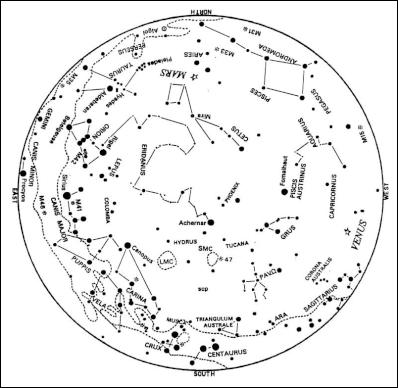Brian Carter's The Night Sky
Carter Observatory - The National Observatory Of New Zealand
The December Night Sky
December is the month of the shortest nights for looking at the stars, but gives more time for daytime activities.
Planets
December is a good month for viewing the planets. Venus, Mars, Jupiter and Saturn will be visible for the whole of the month, and Mercury for all but the first few days of the month.
Venus can be seen in the evening sky. December is the last full month that it will be seen in the evening sky before January 2007. At the start of the month it sets at 23:57 and by the end at 21:59. Venus starts the month in the constellation of Sagittarius, moving into Capricornus on December 14. At the start of the month its magnitude is –4.6, peaking at –4.7 (it’s brightest for the year) on December 12 and then fading to –4.5 by month’s end.
Mars will be visible for the first three quarters of the night. At the start of the night it sets at 04:16 and at 02:19 by month’s end. Mars is in the constellation of Aries, in which it remains until 2006 February. Its magnitude fades from –1.6 to –0.6 during December.
Saturn will be visible for the last two thirds of the night. At the start of December it rises at 00:41 and at 22:36 by month’s end. Saturn is in the constellation of Cancer, in which it remains until September 2006. Its magnitude slightly brightens from 0.2 to –0.1 during the month.
Jupiter will be visible for the last quarter of the night. At the start of the month it rises at 04:15 and by month’s end at 02:32. Jupiter is in the constellation of Libra, in which it remains until December 2006. Its magnitude slightly increases from –1.7 to –1.8 during the month.
Mercury will be visible in the morning twilight for all but the first few days of December. At the start of the month it rises at 05:13 (30 minutes before Sunrise) and at 04:44 by month’s end. Mercury starts the month in the constellation of Libra, moving into Scorpius on December 15 and finally into Ophiuchus on December 19. Its magnitude rapidly rises from 1.3 to –0.5 by month’s end.
All times are for Wellington unless otherwise stated. Other centres may vary by a few minutes.
Phases of the Moon
New Moon – December 2 at 04:01
First Quarter – December 8 at 22:36
Full Moon – December 16 at 05:15
Last Quarter – December 24 at 08:36
New Moon – December 31 at 16:12
Summer Solstice
The Summer Solstice is at 07:35 on December 22. This is when the Sun is at its most Southerly point in the sky and therefore reaches its maximum altitude for the year at the middle of the day.
Mathematically, the longest day is December 22 and the shortest night is December 21/22. We say mathematically, as the days and nights are longest or shortest by only a few seconds, whereas actual Sunrise and Sunset times can vary by 3 or 4 minutes with the calculated times, due to atmospheric conditions.
After December 22 the length of the day will slowly shorten, although this will hardly be noticed for several weeks.
Diary of Astronomical Phenomena
Dec 2 New Moon at 04:01
4 Mercury
stationary against the background stars at 14:00, as its
motion changes from a Westerly to an Easterly
direction.
5 Moon at perigee (closest to the Earth) at
18:00. (Distance = 0.0024557 AU = 367,370 km).
9 Venus at
its greatest brilliance for the year in the evening.
11 Mars stationary against the background stars at
12:00, as its motion changes from a Westerly to an Easterly
direction.
13 Mercury at greatest Westerly elongation
from the Sun (21) at 02:00.
16 Full Moon at
05:15.
19 Saturn close to the Moon as they both rise
about 23:30.
20 & 21 Mercury close to Antares in the
morning twilight. Antares (alpha Scorpius) is a red
supergiant at a distance of ~400 light years.
21 Moon at
apogee (furthest from the Earth) at 16:00 (Distance =
0.0027074 AU = 405,020 km).
22 Summer Solstice at
07:35.
23 Venus stationary against the background stars
at 18:00, as its motion changes from an Easterly to a
Westerly direction.
26 Spica very close to the Moon at
03:00. Spica (alpha Virgo) is at a distance of ~260 light
years.
31 New Moon at 16:12.
DECEMBER SKY CHART
This chart shows the sky as it appears at about 22:00 for December.

Click for big version
How To Use the Sky Charts
To use the sky chart hold it up to the sky so that the direction in which you are looking is at the lower edge of the map. For example, if you are looking at the western horizon then the map should be held so that the “WEST” label is at the lower edge. The altitude and direction of the stars and planets will then be correctly shown. The centre of the chart will be directly overhead.


 Eugene Doyle: The Fall Of Saigon 1975 - Fifty Years Of Repeating What Was Forgotten
Eugene Doyle: The Fall Of Saigon 1975 - Fifty Years Of Repeating What Was Forgotten Peter Dunne: Dunne's Weekly - Trump's Tariffs Still Pose Risks For New Zealand
Peter Dunne: Dunne's Weekly - Trump's Tariffs Still Pose Risks For New Zealand Keith Rankin: Barbecued Hamburgers And Churchill's Bestie
Keith Rankin: Barbecued Hamburgers And Churchill's Bestie Gordon Campbell: On Why The US Stands To Lose The Tariff Wars
Gordon Campbell: On Why The US Stands To Lose The Tariff Wars Eugene Doyle: Before It’s Too Late - Reimagine New Zealand’s Military Future
Eugene Doyle: Before It’s Too Late - Reimagine New Zealand’s Military Future  Binoy Kampmark: Gender Stunts In Space - Blue Origin’s Female Celebrity Envoys
Binoy Kampmark: Gender Stunts In Space - Blue Origin’s Female Celebrity Envoys